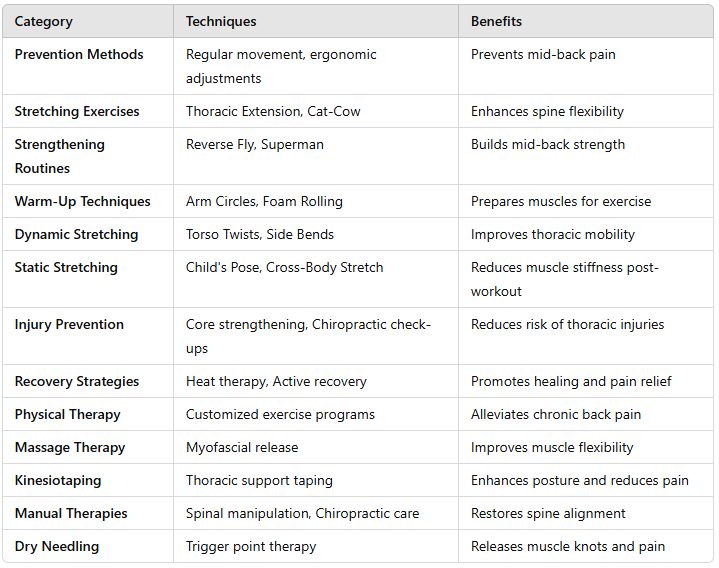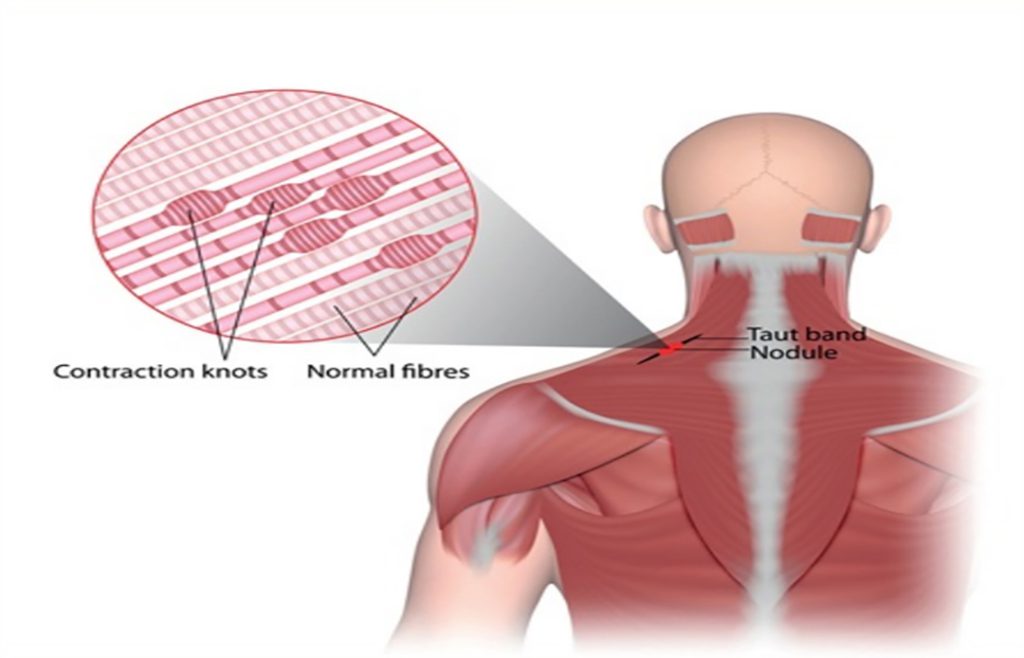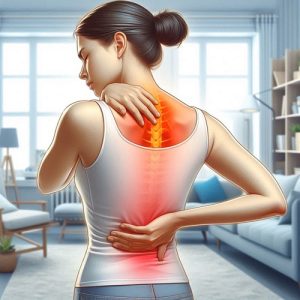Introduction
Dealing with mid-back pain can be a frustrating experience, especially when it affects your day-to-day activities. The mid-back, also known as the thoracic spine, is a critical region that plays a vital role in overall spine health, posture, and upper body movement. Unlike the more flexible cervical and lumbar spine sections, the thoracic spine is designed for stability and protection of vital organs, which can sometimes make it prone to stiffness and discomfort.
Mid-back pain, often caused by poor posture, muscle tightness, or lack of mobility, can disrupt your routine and lead to chronic issues if left unaddressed. This article focuses on mastering mid-back mobility exercises to alleviate thoracic spine pain and promote spine health. By incorporating specific thoracic spine exercises, you can achieve better back flexibility, improved posture, and effective pain prevention strategies.
Whether you’re a desk worker suffering from poor posture, an athlete looking to improve performance, or someone experiencing back discomfort, this guide will walk you through the importance of mobility exercises and provide actionable techniques for long-term relief. So, if you’re ready to enhance your spine alignment and overall wellness, read on!
1. Understanding the Importance of Mid-Back Mobility
What Causes Thoracic Spine Pain?
The thoracic spine, which encompasses the middle 12 vertebrae of the spine, is designed for stability and plays a critical role in maintaining an upright posture. However, factors like prolonged sitting, slouching, or lack of movement can lead to decreased mobility in this region. Common causes of thoracic spine pain include:
- Poor Posture: Slouching and forward head posture can strain the thoracic spine.
- Muscle Imbalances: Weakness in the core and overworked back muscles can contribute to mid-back pain.
- Lack of Movement: A sedentary lifestyle reduces spine flexibility, leading to stiffness.
- Injury: Trauma or repetitive strain can cause muscle tightness and discomfort.
Improving thoracic mobility not only alleviates mid-back pain but also supports core stability, enhances functional movement, and prevents injuries. Let’s dive into the essential exercises and techniques to master mid-back mobility.
2. Prevention Methods for Mid-Back Pain
General Strategies for Pain Relief
Prevention is the key to managing thoracic spine pain effectively. Here are some general strategies:
- Regular Movement: Avoid prolonged sitting by taking frequent breaks to stretch and move around.
- Ergonomic Adjustments: Optimize your workspace with ergonomic chairs and proper screen height to support your back.
- Proper Lifting Techniques: Use your legs to lift heavy objects and avoid rounding your back.
- Hydration & Nutrition: Staying hydrated and consuming a nutrient-rich diet supports muscle and joint health.
3. Stretching Exercises for Thoracic Mobility
Stretching is crucial for releasing tension in the mid-back and improving spine flexibility. Here are some effective stretching routines:
1. Thoracic Extension Stretch
- How to Perform: Sit on a chair with your feet flat on the floor. Place your hands behind your head, elbows out. Slowly arch your back over the chair while looking up.
- Benefits: This stretch improves thoracic spine extension and combats forward-rounded posture.
2. Cat-Cow Stretch
- How to Perform: Start on your hands and knees. Inhale as you arch your back (cow), then exhale as you round your spine (cat).
- Benefits: Enhances spinal flexibility and stretches the mid-back muscles.
3. Thread the Needle
- How to Perform: On all fours, reach one arm underneath your body, rotating the torso until your shoulder touches the ground. Hold for a few seconds and repeat on the other side.
- Benefits: Great for increasing thoracic rotation and relieving tension in the upper back.
4. Strengthening Routines for a Healthy Spine
Building strength in the muscles surrounding the thoracic spine is essential for pain prevention and improved posture. Here are some effective strengthening exercises:
1. Reverse Fly
- How to Perform: Using light dumbbells, hinge at your hips with a slight bend in your knees. Lift the weights to the side until your arms are parallel to the floor.
- Benefits: Strengthens the rhomboids and rear deltoids, improving posture and thoracic stability.
2. Superman Exercise
- How to Perform: Lie face down with arms extended forward. Lift your arms, chest, and legs off the ground, squeezing your back muscles.
- Benefits: Strengthens the entire posterior chain, including the thoracic spine.
3. Seated Rows
- How to Perform: Use a resistance band or cable machine. Pull the handles towards you while keeping your elbows close to your body.
- Benefits: Strengthens the middle back muscles and improves posture.
5. Warm-Up Techniques to Prepare for Exercise
Proper warm-up techniques are essential to prepare your thoracic spine and prevent injuries. Here are some specific warm-up exercises:
- Arm Circles: Helps loosen up the shoulder girdle and mid-back.
- Foam Rolling: Targets the thoracic spine area to release tightness and improve blood flow.
- Dynamic Cat-Cow: Incorporates movement to stimulate thoracic flexibility before exercise.
6. Dynamic Stretching for Improved Flexibility
Dynamic stretching involves active movements that take your joints through their full range of motion. These are ideal for warming up the thoracic spine:
- Torso Twists: Stand with feet hip-width apart and twist your upper body side to side.
- Side Bends: Reach your arm overhead and bend to the side to stretch the lateral thoracic muscles.
7. Static Stretching for Post-Workout Recovery
After intense workouts, static stretching helps lengthen muscles and reduce stiffness. Here are some recommended static stretches:
- Child’s Pose: Kneel on the ground, extend your arms forward, and rest your forehead on the floor.
- Cross-Body Shoulder Stretch: Pull one arm across your body, holding it with the opposite hand.
8. Injury Prevention Techniques
Injury prevention is crucial for those who frequently experience thoracic spine discomfort. Key strategies include:
- Maintaining Core Strength: A strong core supports the thoracic spine and prevents overcompensation.
- Regular Chiropractic Check-Ups: Regular adjustments can help maintain spine alignment and prevent pain.

9. Recovery Strategies for Mid-Back Pain Relief
Effective recovery strategies promote healing and reduce pain flare-ups:
- Active Recovery: Incorporate low-impact activities like walking or swimming to maintain mobility.
- Heat Therapy: Apply heat packs to the mid-back area to reduce muscle tightness.
- Hydration & Anti-Inflammatory Diet: Drinking plenty of water and eating foods rich in omega-3 fatty acids can help reduce inflammation.
10. Physical Therapy and Massage Therapy for Thoracic Spine
If you’re struggling with persistent mid-back pain, professional help may be needed:
- Physical Therapy: A trained therapist can provide a personalized exercise program to strengthen the thoracic spine.
- Massage Therapy: Regular massages can help release tight muscles and improve circulation in the mid-back area.
11. Kinesiotaping for Thoracic Support
Kinesiotaping is a technique used to provide support and pain relief for the thoracic spine:
- How It Works: Kinesiotape lifts the skin to reduce pressure on pain receptors, promoting better blood flow.
- Benefits: Helps reduce pain and improve posture, especially in athletes.
12. Manual Therapies for Thoracic Mobility
Manual therapies like chiropractic adjustments can help restore thoracic mobility and alleviate pain:
- Spinal Manipulation: A chiropractor uses controlled force to realign the thoracic vertebrae.
- Myofascial Release: This technique involves applying pressure to tight muscle areas to release tension.
13. Dry Needling for Pain Relief
Dry needling is an advanced technique for relieving thoracic spine pain:
- How It Works: Thin needles are inserted into trigger points to release muscle knots.
- Benefits: Improves blood flow and reduces muscle tightness in the mid-back region.



